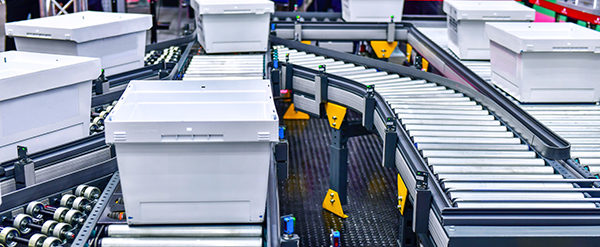Tradition meets high technology
DC automation strategies are increasingly intelligent and flexible, combining the newest technologies with tried-and-true conveyors for optimal performance.

Demand for high-tech material handling equipment is on the rise as more companies seek to automate their distribution centers (DCs), but there’s still plenty of room for tried-and-true systems, especially conveyors and sorters. As DCs automate to accommodate growing e-commerce volumes, industry experts say flexibility and the integration of different technologies are often at the heart of a company’s automation strategy.
Omer Rashid, vice president, solutions design, for contract logistics specialist DHL Supply Chain, says demand for customized solutions is driving many of today’s automation projects, and he refers to a growing “tool belt” of options that include both traditional “bolted to the ground” equipment like conveyors and more flexible robotic technology, such as autonomous mobile robots (AMRs). In high-volume operations, where the return on investment in traditional systems tends to be high, companies are increasingly looking at ways to integrate both types of technologies.
“In some cases, [robotics are] replacing conveyors because of their flexibility, but at the same time, we haven’t seen the demand for conveyance go down,” Rashid explains, adding that equipment makers are advancing how the technologies work together, especially for picking. “In general, there is an automation tool belt that has expanded and gotten much bigger. Ultimately, having flexibility in whatever solution you put in may seem like a buzz phrase, but it’s necessary.”
It’s what’s happening in the market, he says.
Here’s a look at how demand for conveyors and sorters is shaping up in 2021, and how systems are advancing to meet changing needs.
CONVEYOR DEMAND RISES
The first few months of 2021 saw double-digit increases in demand for conveyor equipment, according to the Conveyor Equipment Manufacturers Association (CEMA), which tracks orders and shipments of bulk and unit-handling conveyor equipment monthly. Booked orders for conveyor equipment rose 24% and shipments rose 38% year over year in January, followed by a 35% increase in orders and a 39% increase in shipments in February, the group said. Booked orders for March declined year over year but were up 28% consecutively, and monthly shipments increased 63% compared with a year ago.
The statistics reflect the growing demand for both traditional and integrated material handling projects. Chris Slover, vice president of sales for systems integrator Fortna, says more and more conveyor systems are being designed to integrate with robotic picking technologies—where a conveyor system may deliver products to a robotic picking arm, for example—and even with competing technologies such as AMRs. Depending on the operation, clients may use conveyors in one part of a DC, AMRs in another, for example.
“Where you can integrate systems and use robotics—AMRs as an example—we are seeing a rise in that for sure,” says Slover, adding that many companies are looking for ways to be free of bolted-down technology where possible but still utilize more traditional systems where they work best—especially in high-throughput applications.
Slover points to advances in conveyors and sorters that allow for handling a wider array of items at varying speeds, as one example. He also notes the growing popularity of motor-driven roller (MDR) systems, in which the conveying surface is powered by independently driven motors, in zones, and that allow for the buffering or accumulation of products. MDR systems are typically quieter, more energy efficient, and easier to implement than traditional conveyor systems, he explains. They are also more expensive, but, as with most technology, the cost is coming down over time.
For many companies, the sheer volume increases they’ve seen in the past year are making cost less of an obstacle as they strive to get orders out the door even faster.
“Labor availability and the move to e-commerce [have] put [more] emphasis on … order picking and fulfillment,” Rashid adds. “Conveyance, sortation, robotics—we see an acceleration of that as a result.”
EQUIPMENT GETS SMART
The next big breakthrough in conveyor technology is likely to come in the control aspects of the systems, particularly in how the conveyor functions in relation to warehouse execution systems (WES) running in a facility. Slover says the application of artificial intelligence (AI) and machine learning to the “smarts” of a conveyor system will help optimize flows, drive even more efficiency, and improve productivity.
“How am I controlling the conveyor? That’s where I think you’ll see the most innovation,” he says.
Slover uses the example of global positioning system (GPS) technology and mapping software to illustrate his point. Drivers don’t need to consult paper maps for the best route to a given destination when they have programs like Google Maps or Waze at their fingertips to intelligently set them on the most efficient path. A box on a conveyor may benefit from the same kind of technology.
“There may be ways that the control system itself can reroute and avoid potential traffic jams, for example, or [create] a more intelligent release of work to the conveyor—or smooth out the flow of the system itself,” Slover explains, adding that such advances could help companies avoid “overautomating” to get a better return on their conveyor assets.
Rashid agrees that advances in software are likely to be the biggest changes ahead—changes that enable even greater flexibility in designing the right system for the job.
“Those advances will allow us to build bespoke solutions that are ultimately flexible for our customers’ business needs,” he says. “More and more, we’re partnering with our customers who are looking at their business one, three, five years out, and they need to look at different alternatives. Customers ask ‘My volume could go in one of three directions—what solution will give us the ability to satisfy those in a cost-effective way?’ We’re helping them build a roadmap.”
The more tools available to create the map, the better.
Related Articles
Copyright ©2024. All Rights ReservedDesign, CMS, Hosting & Web Development :: ePublishing